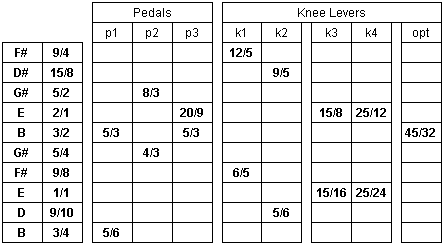Part of the harmonic beauty of the pedal steel sound can be attributed to the tuning system used by most steel guitarists. The technical term for our system of "tuning the beats out" is Just Intonation.
Just Intonation theorists usually express tuning systems in terms of ratios from a fundamental frequency. The following chart shows the tuning ratios of a typical Nashville E9th pedal steel copedent:

Many steel guitarists add a compensator on the first or second pedal to lower the 7th string F# from 9/8 (the large major second) to 10/9 (the small major second). This pulls the string in tune with the "A" tonality of the pedals down (p1+p2) position. In the higher octave, the "two F#'s problem" is solved by tuning the 4th string F# change (p3) different from the 1st string F#.
The following table shows the size, in cents, of the relevant JI intervals between 1/1 and 2/1. The other notes in the tuning are octaves of these.
| ratio | cents |
|---|---|
| 2/1 | 1200.0 |
| 15/8 | 1088.3 |
| 9/5 | 1017.6 |
| 5/3 | 884.4 |
| 3/2 | 702.0 |
| 45/32 | 590.2 |
| 4/3 | 498.0 |
| 5/4 | 386.3 |
| 6/5 | 315.6 |
| 9/8 | 203.9 |
| 10/9 | 182.4 |
| 25/24 | 70.7 |
| 1/1 | 0 |
These intervals are the ideal. In practice, almost all pedal steel guitars detune slightly when a string is pulled due to physical stresses on the instrument. Some players accommodate this so-called "cabinet drop" effect by tuning slightly closer to the equally tempered notes (100, 200, 300, etc.).
Copyright 1997, 2011 by Bobby Lee